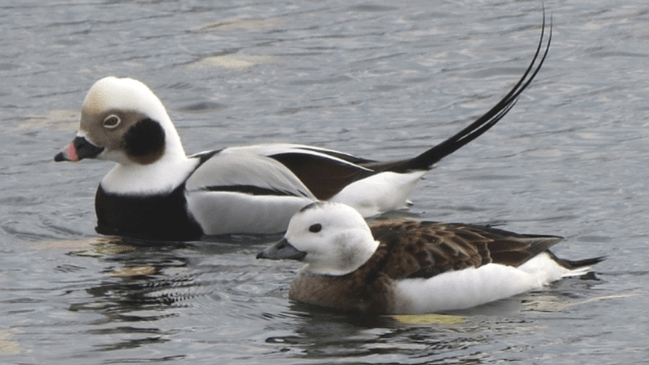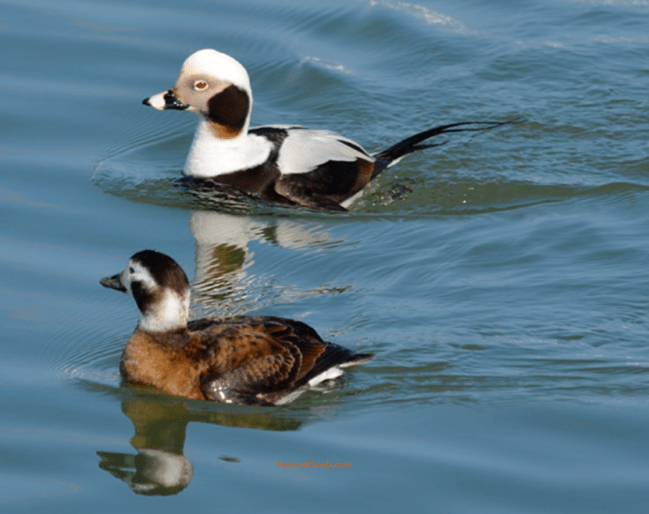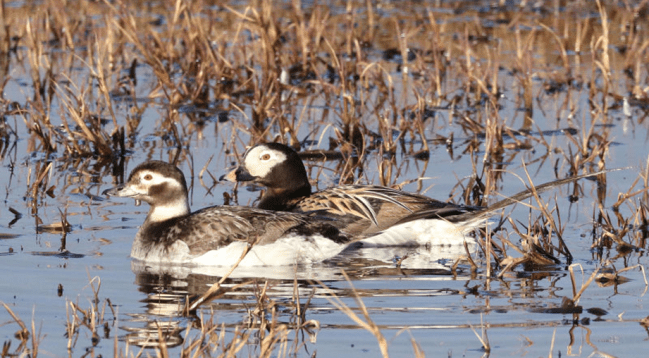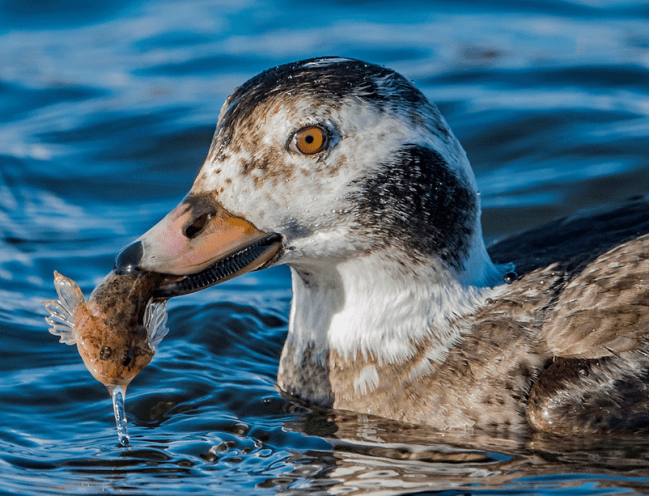Dr. James J. S. Johnson
Let them give glory unto the LORD, and declare [yaggîdû = hiphîl imperfect 3rd person masculine plural of nâgad, “to appear”, “to be clear”] his praise in the islands.
(Isaiah 42:12)

Recently, when reviewing a bird-book that presented seabirds of the Hebrides, I noticed a duck’s name that I was unfamiliar with, the “Long-tailed Duck” [see Peter Holden & Stuart Housden, RSPB Handbook of Scottish Birds, 2nd edition (Bedfordshire, UK: Bloomsbury Publishing / Royal Society for the Protection of Birds, 2016), page 39]. However, I recalled that I’d seen similar-looking ducks, in near-freezing wetland pond-water, from a train-car of the White Pass and Yukon Railway, traveling from Skagway (Alaska) into British Columbia, about 20 years ago, probably during early September, when these ducks visit migratory stopover sites.
So, what does a Long-tailed Duck look like? For starters, the male (a/k/a drake) has a conspicuously long tail—that makes sense.
Smaller than Mallard, but tail of male may add 13 cm [about 5 inches]. Small, neat sea duck with a small, round head, steep forehead, all-dark wings in flight and white belly. In winter, male is mainly white with a dark brown “Y” mark on its back, brown breast-band and a large, dark cheek patch. In summer, it has a streaked brown back, dark head and neck, and pale greyish-white face patch. Adult male has greatly elongated central tail feathers. Female in winter shows a white collar, white face with dark lower cheeks and dark crown. … In summer, female has a darker face than in winter. Females have short tails. Juvenile is like female in summer, but with a less contrasting face pattern. Flight feathers are moulted between July and September; during part of this time birds are flightless for a few weeks. Has a unique moult, as some back feathers are moulted four times a year and some head and neck feathers three times a year.
[Peter Holden & Stuart Housden,”Long-tailed Duck”, RSPB Handbook of Scottish Birds, 2nd ed. (Bloomsbury / Royal Society for Protection of Birds, 2016), page 39.]

Does that physical description sound familiar? Do the photographs look familiar?
After some research I realized that certain cold-weather diving ducks, called “Oldsquaw” ducks in older guidebooks [e.g., James Kavanagh, The Nature of Alaska (Blaine, WA: Waterford Press, 1997), page 56], are now called “Long-tailed Duck” in newer guidebooks [e.g., Robert H. Armstrong, Guide to the Birds of Alaska, 6th edition (Portland, OR: Alaska Northwest Books, 2019), page 54]. But why?
Surely this is an odd duck. In fact, its typical call is an odd quacking-warbling-hooting honk, sounding like a duck trying to yodel through a semi-muted horn.
The duck’s fancy scientific name, Clangula hyemalis, has not changed lately.
But political pressure intrudes into the mostly-apolitical ornithology neighborhood. It seems that the earlier common name for this duck, “Oldsquaw”, is now deemed unacceptable, because it might offend someone who stumbles on the terms “old” and “squaw”, as imagining disrespectful stereotypes of elderly tribeswomen. Although “P.C.” (i.e., political coërcion) pressures should not dictate taxonomy for ornithologists, there you have it—since the International Ornithologists’ Union has acted, so now all Oldsquaws are re-named “Long-tailed Ducks”! What a world!

Ironically, to eschew the prior common name (“Oldsquaw”) implies that folks often disrespect old squaws, i.e., elderly womenfolk of the Native American tribes. But why should someone be ashamed of being “old”? It is a blessing to be given many years of earthly life (Leviticus 19:32; Proverbs 16:31 & 20:29b; Job 12:12). Likewise, why should an Indian woman—or any woman—be ashamed of being a “squaw” (i.e., a woman)? It is a blessing and a privilege to be whomever God creates someone to be. After all, God did not need to create anyone who would live long enough to become an old “squaw”, or an old “brave”, for that matter. It is God’s generous and providential grace that we are whomever we are—because God could have made us all Long-tailed Ducks, or Coots, or Gooney Birds, or Grackles!
While God appreciates the “simple”, yet unique, snowflakes that are ignored by busy humans, God treasures our personal lives (created in His image) infinitely more, as though we were His precious jewels (Malachi 3:17). In fact, God providentially planned our lives to be exactly what they are, and if we belong to Him, God artistically “works together for good” the component details of our lives (Romans 8:28). Surely, we should thank our Lord Jesus Christ for being our very personal Creator. So, the next time you see a grackle, think thankfully for a moment, “That could have been me!” And be grateful to your Creator, Who made you a unique, one-of-a-kind creation.
[Quoting JJSJ, “Of Grackles and Gratitude”, ACTS & FACTS, 41(7):8-10 (July 2012), posted at www.icr.org/article/6900/ .]

Meanwhile, back to the Oldsquaw’s cold-weather life in and near northern ocean seawaters. The Long-tailed Duck is a sea-duck, spending most of its winter days at sea (not very close to shoreland), diving for food, though using arctic tundra, taiga (i.e., boreal forest), and subarctic coastlands for breeding, and for latter-month molting and migratory stopovers. It’s a diving duck, sometimes diving to depths of 200 feet, using their feet to propel themselves downward, staying underwater moreso (i.e., longer) than other diving ducks. And oxygen-rich coldwaters contain lots of nutritious food for the Long-tailed Duck.
Dives to search mainly for crustaceans and molluscs, especially Blue Mussels, cockles, clams and crabs. Also eats sandpipers, small fish such as gobies and some plant material.
[Peter Holden & Stuart Housden,”Long-tailed Duck”, RSPB Handbook of Scottish Birds, 2nd ed. (Bloomsbury / Royal Society for Protection of Birds, 2016), page 39.]

Wonderful birds are there to be seen, in the Outer Hebrides (“Western Isles”). If you get the opportunity, go see them! Meanwhile, appreciate that they are there, living their daily lives—filling their part of the earth—and glorifying their Creator.
><> JJSJ profjjsj@aol.com
Thanks, Dr. Jim, for a very interesting article. I guess I would qualify for being an “old squaw”! :) I am getting older by the day, praise the Lord, and I’ve been married 58 years. That pretty well qualifies me for being an ‘Old Squaw!” Praise the Lord!
LikeLiked by 1 person
There’s something magnificent about sea-birds found at/near islands (and other other coasts). It’s amazing–these birds are at home in the air, and at sea, and on land — as is illustrated by my recent info on puffins ( http://www.icr.org/article/puffins/ ).
LikeLiked by 1 person
Beautiful duck
LikeLiked by 2 people
Yes, Vimal — and so is the splendid Common Teal that you have displayed on your website @ https://nepalfulveta.wordpress.com/ .
LikeLiked by 2 people
Thanks so much for taking time to share this information – we appreciate learning about these beautiful creatures from a biblical perspective. May the tribe of God-fearing ornithologists and scientists increase for His glory!
LikeLiked by 1 person
Thanks for the encouragement.
LikeLiked by 1 person
Most interesting post Dr Jim, we would love to visit there one day, we loved birding in the UK .
LikeLiked by 2 people